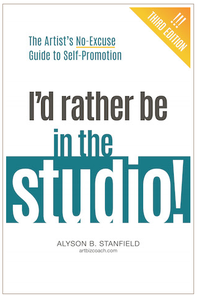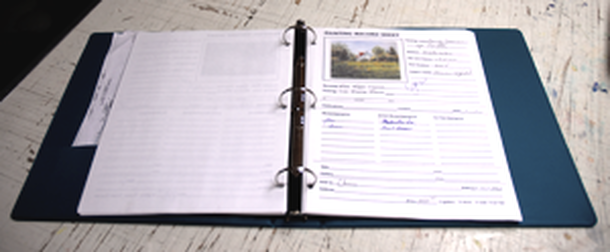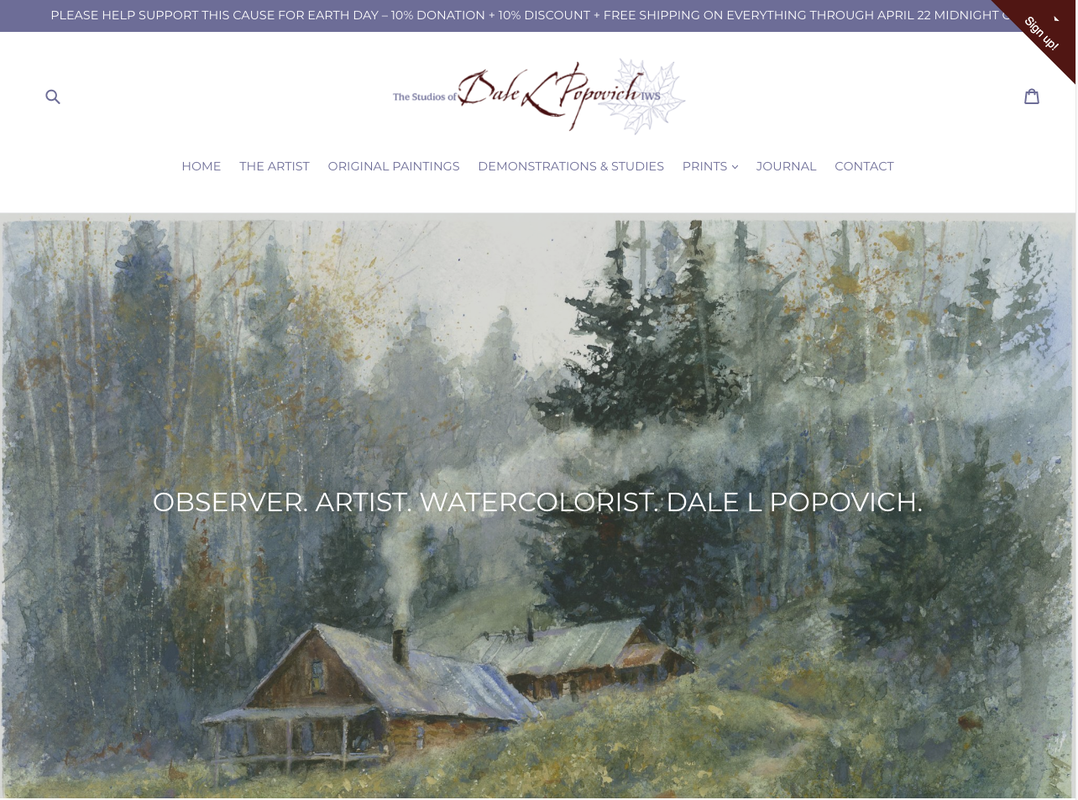|
I published this blog post five years ago, but this information is just as valid today as it was back then. By the way, Alyson A Stanfield has updated her book and no longer is in print but is offered for your iPad and Kindle. One of the things I regret not doing in my art career was keeping better records in the early days. I wonder what the paintings I created look like now that was presented in my first group show at the 212 Gallery in the Palmer House, Chicago, exactly which 35 paintings were in my first One-Man Show in Oak Park, IL in 1986 and the names of the many, many people who bought my art. No slides, no notes, and no records. All I wanted to do was paint – not concerned about my history. Well, things have changed. Every time a painting is completed, it's photographed, and an inventory sheet is started. Additional notes are written on the back and receipts stapled to it, all kept in a ring-binder. Digital photos are stored on a separate external hard drive. Attached is an editable Inventory Sheet Template PDF we have developed for my own paintings. Once you have downloaded the PDF and saved a master copy (make a document for each painting) place your cursor in the light violet box and type. If you are using Adobe Acrobat full version, you can attach a photo(s) to the Inventory Sheet. Of course, you can print out the sheet and do it old school with a pencil or pen. Painting Inventory Sheet PDF THE ART MARKETING BOOK FOR ARTISTS WHO WANT TO SELL MORE ART
Alyson's history has helped mold this book. As you can see she has the resume to back her business. She was an Assistant to U.S. Senator for 2 years, Museum Curator for 4 years, Museum Educator for 6 years, an Art Collector for 20 years and an Art History Grad Student. 
'I’d Rather Be in the Studio! The Artist’s No-Excuse Guide to Self-Promotion’ by Alyson B. Stanfield can be purchase at her website http://artbizcoach.com.
Also check-out her blog, facebook page and get her weekly newsletter. http://artbizblog.com andhttp://facebook.com/artbizcoach TIP: Buy her book from her personal website. I know you can find it for a few dollars cheaper on Amazon but she gives you additional freebies. Here's an excerpt from Alyson's book regarding keeping a record of your artwork with her permision. INVENTORY YOUR ARTWORK I have an instructional story to share with you. I met with an elderly man (I'll call him Mr. Smith) whose wife had Alzheimer's. She had been a painter and was now in a nursing home. He was interested in selling off her works. It wasn't money he was after. He was simply trying to find nice homes for the paintings. Mr. Smith showed me his wife's resume along with slides (unlabeled) of her work. Her resume revealed that she had exhibited in a variety of annual shows in her home state, but no dates were given. Mr. Smith wanted me to estimate a value for the paintings so that he could price them. I don't appraise artwork, but I often talk with artists about pricing their art and could have worked with him on that. However . . .Mr. and Mrs. Smith may indeed have had many more records, but they were probably packed away without much order and it would have required a great deal of effort to get to them. It was effort he didn't seem willing to make. Without dates and sales records, it was difficult to devise a fair pricing scale. There are three lessons to be learned from this story. 1. Keep a meticulous inventory of your art. If you don't have an updated inventory list, it's hard to tell what you have available. No one-not even you-would beable to tell quickly what titles you have, what the works are, what the dimensions are, and which works have sold. 2. Track your sales record. If you don't keep track of dates and prove that your reputation has grown and sales have increased, there is no reason to believe that your works would have gone up in value. (Try telling the IRS that you don't know where things are or what happened to them.) Don't leave the dirty work for someone else to tackle when you're gone. Keep this story in mind whenever you question spending time inventorying your artwork. If you're just starting out, keeping an inventory may seem like overkill. As your career blossoms, you'll be thrilled you set up systems to grow with you. CATEGORIES FOR YOUR INVENTORY Consider these categories for your inventory records, adapting to your specific needs. Name of artist. Presumably you are the creator of all the works in your database, but add the names of any collaborators. Title. Titling your works. (1) differentiates them from one another; (2) makes it easier for others, such as critics, to identify them and to write about them; (3) helps people relate better to your subject matter or intent by giving them clues; and (4) allows search engines to find your subjects when they’re online. Location. Exactly where each item in your inventory can be found at any given moment. Image availability. What images, views, and details do you have of this artwork? Date. Keep track of the date you complete your work and make note of it on the artwork. Foundry. Record the location of the casting and with whom you worked. Print shop. If you work with a master printer, log that information. Support. Is it on canvas? Board? Paper? Primer. What did you use to prepare your surface? Medium. Be specific. Someday a curator or conservator will come to you and ask you how to conserve one of your artworks. You should be able to exactly describe the medium you used so that the work is cared for properly. Technique. For some mediums, this category will be more important than for others. A fiber artist, for instance, might note “hand-appliquéd, machine-quilted.” Varnish / Patina. Again, be precise. Size. Art is always listed as height by width by depth in inches or centimeters (never width by height by depth). Keep a record of size both with and without the frame. Sales price. Your sales price is always listed as the retail price. Frame. Description and size. Note framer if other than you. Materials cost. This category should be included since you need to keep track of it for tax and pricing purposes. Provenance. The provenance of an artwork is its history. It includes when and where it was exhibited and who has owned it (in some cases, there may be a sequence of owners). Provenance is invaluable when determining ownership of disputed works of art. Image availability. Do you have 35 mm slides of this artwork? Prints? Four-by-five negatives? Digital? Related notes or stories about the work. Notes or accounts of the work will be impressive and be equally informative when you print it out next to the image in the same database.
0 Comments
Leave a Reply. |
Dale L Popovich IWSDale is an award-winning watercolorist and teacher passionate about capturing the raw beauty of the American landscape with the fluid stroke of a brush. As you will see, the works selected in his portfolio represent the depth of his holistic approach to painting. You can also learn with this talented and experienced teacher through his workshops, Palette & Chisel, and Popovich Studio classes. Archives
April 2024
Categories
All
|
|
INSTRUCTOR
Palette & Chisel 2024 Workshops & Demos ONLINE LEARNING Watercolor Escape Saturdays TIPS and TECHNIQUES Thursdays ZOOM Palette & Chisel Academy of Fine Arts ADDITIONAL INFORMATION Popovich's Field Journal Newsletter WATERCOLOR ART SUPPLIES Watercolor Paints Watercolor Brushes Watercolor Supplies DALE L POPOVICH IWS LIBRARY Books & DVDs BUSINESS BOOKS LIBRARY Books & Podcasts |
©2024 Dale L. Popovich. IWS, Drawing & Painting TIPS and TECHNIQUES Thursday, In the Comfort of Your own Studio tm, Towering Winds Academy of Fine Arts tm, and Teaching People to Truly See tm All Rights Reserved.
|
|
©2024 Dale L Popovich, Towering Winds Academy of Fine Arts and The Studios of Dale L Popovich IWS. All rights reserved
Copyright © 2024 Rosemary & Co Artist's Brushees LTD |

Handmade and maintained by POPovichDESIGN
[email protected] |




 RSS Feed
RSS Feed
